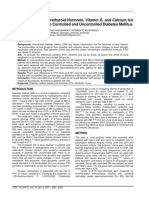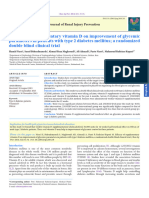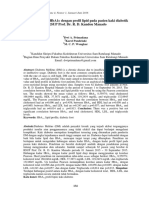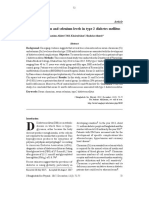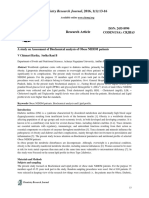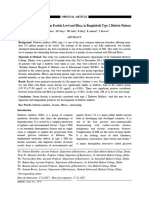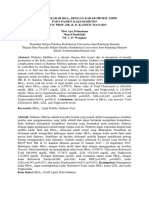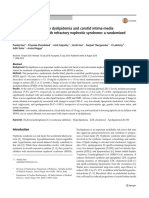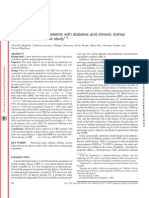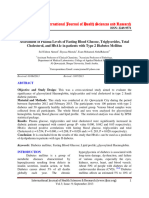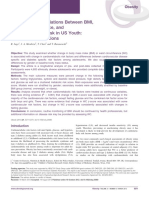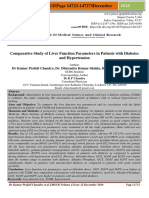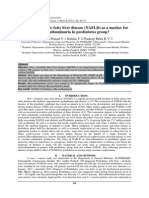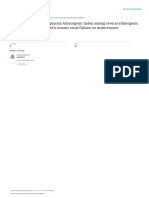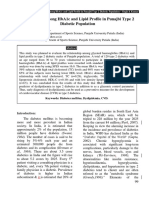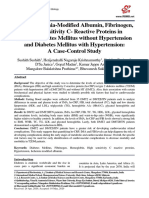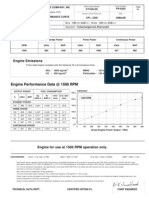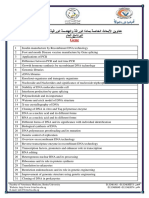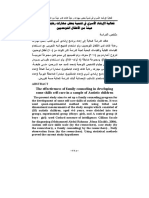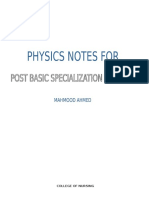Correlation Between Fasting Blood Glucose and Hba1c With Vitamin D in Diabetes Mellitus
Correlation Between Fasting Blood Glucose and Hba1c With Vitamin D in Diabetes Mellitus
Uploaded by
Erizal Dwi HandokoCopyright:
Available Formats
Correlation Between Fasting Blood Glucose and Hba1c With Vitamin D in Diabetes Mellitus
Correlation Between Fasting Blood Glucose and Hba1c With Vitamin D in Diabetes Mellitus
Uploaded by
Erizal Dwi HandokoOriginal Description:
Original Title
Copyright
Available Formats
Share this document
Did you find this document useful?
Is this content inappropriate?
Copyright:
Available Formats
Correlation Between Fasting Blood Glucose and Hba1c With Vitamin D in Diabetes Mellitus
Correlation Between Fasting Blood Glucose and Hba1c With Vitamin D in Diabetes Mellitus
Uploaded by
Erizal Dwi HandokoCopyright:
Available Formats
ORIGINAL ARTICLE
Correlation Between Fasting Blood Glucose and Hba1c with Vitamin
D in Diabetes Mellitus
AKHMAD RAUMULFARO AKBAR1, EDWARD KURNIASETIAWANLIMIJADI2, MEITA HENDRIANINGTYAS2,
K. HERINUGROHO H.S3
1
Faculty of Medicine, Diponegoro University, Semarang, Indonesia
2
Department of Clinical Pathology, Faculty of Medicine, Diponegoro University, Semarang, Indonesia
3
Department of Internal Medicine, Faculty of Medicine, Diponegoro University, Semarang, Indonesia
Jl. Prof. Soedharto SH, Tembalang, Semarang, Central Java, Indonesia, 50275
Correspondence to Edward Kurnia Setiawan Limijadi, Email :edwardksl@fk.undip.ac.id
ABSTRACT
Background: Diabetes Mellitus (DM) is one of the largest health problems in the world. The prevalence of DM in
human population has increased globally. Fasting blood glucose and HbA1c is one of parameters for diagnosing
and monitoring DM. Vitamin D is a fat-soluble vitamin that has a role in glucose tolerance through its effect on
insulin secretion and sensitivity in DM and the vitamin D deficiency condition sometime happened. Further more,
the relation between fasting blood glucose and HbA1c with vitamin D in DM need to be investigated
Aim: To determine the correlation of fasting blood glucose and HbA1c with vitamin D in DM.
Methods: An observational analytic study with cross sectional approach in 46 subjects suitable with the inclusion
and exclusion criterias. This study was conducted from April to September 2019 in Rumah Sakit Nasional
Diponegoro (RSND) Semarang. Variables of this study were fasting blood glucose (FBG), HbA1c levels, and
vitamin D (25(OH)D). Data were analyzed by Spearman and Pearson correlation.Test was significant if p<0,05.
Result: Mean±SDof fasting blood glucose, HbA1c and vitamin D (25(OH)D) were 168,78 ±86,21mg/dL, 8,46±2,20
%, and 15,85±8,75 ng/mL. The correlation between fasting blood glucose and vitamin D were not significant with
p=0,193; r=0,195 and neither the correlation between HbA1c and vitamin D withp=0,153; r=0.214. Conclusion:
Assessment of vitamin D deficiency base on the measurement of the vitamin D in diabetes melitus and this
parameter don’t have correlation with FBG and HbA1c levels.
Keywords: Fasting blood glucose, HbA1c, Vitamin D, Diabetes Mellitus
INTRODUCTION microvascular (retinopathy, nephropathy and
neuropathy)6,7.
Diabetes Mellitus (DM) is one of the largest problems in the The latest guidance from scientific bodies around the
world. In recent years,prevalence of DM in human world recommends measuring 25 (OH) D serum as the test
population has been increased globally1. It has been of choice for assessing vitamin D status.8Serum 25 (OH) D
reported in “Riset Kesehatan Dasar” that the prevalence of levelis the best indicator for assessing vitamin D status
DM in Indonesia for population with aged ≥ 15 years has because 25 (OH) D level reflects the production of skin
increasedfrom 6,9% in 2013 to 8,5& in 20182. vitamin D3 and vitamin D (D2 and D3) from food. 25 (OH)
Diabetes mellitus is defined as a group of metabolic D also has a long half-life in circulation which is 3-4 weeks.
diseases characterized by chronic hyperglycemia caused Although the active metabolite of vitamin D is 1.25 (OH)
by damage of insulin secretion, insulin action or both, 2D, measurement of serum 1.25 (OH) 2D level is not
causing abnormalities in the metabolism of carbohydrates, recommended to determine vitamin D status because the
lipids, and proteins3. half-life in short circulation is 4-6 hours and its level in
The condition of hyperglycemia in DM increases serum is very low when compared with a level of 25 (OH)
reactive oxygen species (ROS) which induces oxidative D. When vitamin D deficiency occurs, parathyroid hormone
stress in pancreatic β cells. This oxidative stress increase secretion will increase as a compensatory response that
the production and release of pro-inflammatory mediators will stimulate the kidneys to increase production of 1.25
(cytokines and chemokines) which activate CYP27B1 (1α- (OH) D so that when vitamin D deficiency occurs, 25 (OH)
hydroxylase), an enzyme that cause 25 (OH) D to be D level are decreased, while level of 1.25 ( OH) 2D is
converted to 1.25 (OH) D, thereby reducinglevel of 25 (OH) maintained at normal or even elevated level9.
D OH) D and increasinglevel of 1,25 (OH) D4,5. Until now then, research on the relationship of fasting
Fasting blood glucose (FBG)was used as a parameter blood glucose and HbA1c level with vitamin D (25 (OH) D)
to distinguish diabetes mellitus patients from non-mellitus levels in diabetes mellitus especially in Indonesia is still
diabetes patients because fasting blood glucose has high limited, and also there were differences in previous studies
specificity. World Health Organization also recommends between these variables. Therefore, it needs advanced
measurement of HbA1c level to diagnose diabetes, HbA1c investigations.
tends to be stable in the blood for a longer period and the
examination can be done at any time without special
preparation. According to Metcalf PA, et al (2017), HbA1c
MATERIALS AND METHODS
has correlation with macrovascular complications An observational study with cross sectional approach was
(cardiovascular disease and ischemic stroke) and conducted in Rumah Sakit Nasional Diponegoro (RSND)
Semarang on April to September 2019. The subjects of the
P J M H S Vol. 13, NO. 4, OCT – DEC 2019 1093
Correlation Between Fasting Blood Glucose and Hba1c with Vitamin D in Diabetes Mellitus
study were 46 diabetes mellitus patients who met inclusion Table 1. Characteristicsof subjects
and exclusion criterias by consecutive sampling. The Parameter Mean± SD
incluson criterias were diabetic patients, >18 years old, Age (years) 57,85± 11,58
normal body temperature, normal liver function test, and Gender (%)
Male 36,96
willing to be respondent, while the exclusion criterias were
Female 63,04
anemia, pregnant, smoker, consuming vitamin D Sport activity (%)
supplements, patient with history of chronic liver, patient Yes 34,78
with history of chronic kidney disease, and stroke patient. No 65,22
Data in this study were identity of the patients, weight, Blood pressure (mmHg)
height, sport activity, blood pressure, percentage of body Sistol 131,89 ± 11,73
fat, hemoglobin levels, AST, ALT, FBG, HbA1c levels, and Diastol 82,83 ± 6,08
25(OH)D levels. Blood sampling, blood presureand the Percentage of body fat (%) 32,56 ± 6,48
percentage of body fat measurement weredone at Male 26,76 ± 6,77
laboratory of RSND. The measurement of hemoglobin Female 35,56 ± 5,03
Body weight (kilograms) 63,19 ± 11,54
levels, AST, ALT, FBG, HbA1c, and 25(OH)D was done at
Height (centimeters) 156,29 ± 7,87
laboratory of RSND, GAKI laboratory faculty of medicine
Body Mass Index (kg/m2) 25,72 ± 4,15
UNDIP, and laboratory of Prodia. Hemoglobin levels (mg/dL) 13,18 ± 0,95
The percentageofbodyfatwasdonebyomron body SGOT (mg/dL) 19,37 ± 5,2
composition monitor HBF-375. Fasting blood glucose were SGPT (mg/dL) 18,65 ± 5,33
measured by GOD-PAP method on automatic clinical Fasting blood glucose (mg/dl) 168,78± 86,21
chemistry analyzer architech C-4000, normal level of FBG HbA1c levels (%) 8,46± 2,20
is ≤ 100 mg/dl. HbA1c levels were measured by high Vitamin D (25(OH)D) levels (ng/mL) 15,85± 8,75
performance liquid chromatography (HPLC) on a D-10
system, normal level of HbA1c is less than 5,7%. 25(OH)D The percentage of body fat in female is higher than
levels were measured by Enzyme-Linked Immuno Sorbent male with BMI obtained in normal to overweight range.
Assay (ELISA )method, normal level of 25(OH) is 30- Fasting blood glucose levels in this study population
100ng/mL. ranged from normal to high, where the proportion of normal
Data analysis was performed by statistical FBG level was less than those of high levels. There were
programme computer. Normality test was Saphiro-Wilk and 21 (45,65%) subjects with normal FBG and 25 (54,35%)
data that were not normally distributed carried out data subjects with increased FBG, while HbA1c levels in all
transformation. Pearson correlation test was performed to subjects of this study were found to be increasing from
test correlation of HbA1c levels with vitamin D (25(OH)D) normal. 25(OH)D levels in this study were found decreased
levels and Spearman correlation was performed to test based on normal values.
relation of fasting blood glucose with vitamin D
(25(OH)D).p>0,05 was significant. Table 2: Correlation test results
Ethical clearance was obtained from the Medical and Vitamin D (25(OH)D)
Variable
Health Research Ethics Commission (KEPK) of the Faculty r p
of Medicine, Diponegoro University. Subjects were given a HbA1c 0,214 0,153a
brief explanation of the purpose, benefits, research Fasting blood glucose 0,195 0,193b
a
protocols, and possible side effects, and written informed Pearson correlation test
b
Spearman correlation test
consent was done.
Data was analyzed by parametric Pearson correlation test
RESULT for HbA1c and vitamin D (25(OH)D) and non-parametric
The population of this study were diabetes mellitus patients Spearman correlation test for fasting glucose test and
in RumahSakit Nasional Diponegoro (RSND) Semarang. vitamin D (25(OH)D). Based on the Pearson correlation test
This study was conducted from April to September 2019 in between HbA1c and vitamin D (25(OH)D), the result shows
RSND Semarang and the samples were examined in there was no significant correlation between HbA1c and
laboratory of RSND Semarang. There were 79 subjects vitamin D (25(OH)D). Based on the Spearman correlation
who were willing to be sampled, but only 46 subjects met test between fasting blood glucose and vitamin D
the inclusion and exclusion criteria. Descriptive are shown (25(OH)D), the result shows there was no significant
in table 1. correlation between fasting blood glucose and vitamin D
The gender distribution in this study was 17 (36,96%) (25(OH)D) as shown in table 2.
males and 29 (63,04%) females. The average age of
respondents was 57.85 ± 11.58 years. The youngest age in DISCUSSION
this study was 34 years and the oldest age was 79 years.
The result of Spearman correlation test between fasting
There were 16 (34.78%) subjects who routinely did sport
activities and there were 30 (65.22%) subjects who did not blood glucose with vitamin D (25(OH)D) showed that there
routinely do sport activities. was no significant correlation. The study conducted by
Alkhatatbeh in 2018 found that there was no significant
relationship between fasting blood glucose with vitamin D
(25(OH)D) in diabetes mellitus10. Tandon in 2014 also
stated there was no significant correlation between fasting
1094 P J M H S Vol. 13, NO. 4, OCT – DEC 2019
ORIGINAL ARTICLE
blood glucose with vitamin D (25(OH)D) in diabetes more frequent in women can also reduce vitamin D
mellitus11. synthesis, and also women have a higher percentage of fat
The result of this study differs from some previous than men thus they have lower concentrations of vitamin D
studies. Study conducted by Pannu in 2017 found there (25 (OH) D) than men. Furthermore, age also affects
was a negative relationship between fasting blood glucose vitamin D level due to reduced production of vitamin D in
and vitamin D (25(OH)D) in DM12. Another study in 2017 by the skin, lack of exposure to UV B sunlight, reduced food
Kanakaraju shows there was a negative relationship intake, reduced skin thickness, impaired absorption in the
between vitamin D (25(OH)D) with blood glucose intestine, and reduced hydroxylation in the liver and
parameters13. The same result was also mentioned by kidneys.In the study conducted by Al-Horani in 2016
Bhatt in 2018 there was a negative relationship between showed that there was a relationship between gender, age,
fasting blood glucose with vitamin D (25(OH)D in pre- and body mass index with vitamin D (25(OH)D) levels25.
diabetic population14. Another factors that can influence HbA1c level in this
Insignificant relationship between fasting blood study is glycation factors which can be influenced by the
glucose and vitamin D (25(OH)D) can be caused by levels of consumption of vitamin C, the levels of
several factors. One of them is the percentage of body fat. consumption of vitamin E, and alcoholism, as well as
Individuals with a high percentage of body fat can reduce Yunika (2017)9. In the study conducted by Ardekani in 2007
level of vitamin D (25(OH)D) because excess fat tissue can showed that consumption of vitamin D decreases serum
store fat-soluble vitamin D thus it reduces vitamin D is level of fasting blood glucose, LDL, and HbA1c
released in the bloodstream and serum 25(OH)D level significantly26.
become low15,16. Limitations in this study are the current study
The use of drugs such as glucocorticoid drugs,anti- subjects,they are not distinguished based on physical
hypertension may affect vitamin D (25(OH)D) level, activity, gender and age. This study also did not distinguish
glucocorticoids may affect function of osteoblasts and DM subjects based on BMI or body fat percentage.
osteoclasts thus it reduces vitamin D levels. Some Medicines were consumed by patients, where the use of
glucocorticoids also increase degradation of 25(OH)D and several drugs such as anti-hypertensive drugs,
1,25(OH)D due activation of pregnane X receptors17. In glucocorticoids, vitamin C supplements, vitamin E
addition, physical activity also affects plasma vitamin D supplements can influence the results of the study.
concentrations, a study conducted by Fernandes in 2017
showed that the concentration plasma vitamin D increases CONCLUSION
with physical activity18. Research conducted by Sakungin
2018 showed that physical activity may increases insulin Relationship between FBG and HbA1c levels with vitamin
sensitivity and increases glucose uptake by body tissues D (25(OH)D) level in diabetes mellitus patients are not
thus it reduce blood glucose level19. significant. Assessment of vitamin D deficiency base on the
The result of Pearson correlation test between HbA1c measurement of the vitamin D in diabetes melitus.The next
with vitamin D (25(OH)D) showed there was no significant study needs to be adjusted with interference factors related
correlation. The study conducted by Kumar in 2017 showed to variables detail that mention in limitation.
that diabetes mellitus could not be proven to have a
significant relationship between HbA1c and vitamin D REFERENCES
(25(OH)D) levels in people with diabetes mellitus20. Coskun 1. International Diabetes Federation. IDF Diabetes Atlas. 8 ed.
in 2012 also stated there was no significant relationship International Diabetes Federation. Brussel: International
between HbA1c with vitamin D (25(OH)D) levels in Diabetes Federation; 2017.
diabetes mellitus21. 2. Kesehatan BP dan P. Hasil Utama Riset Kesehatan Dasar.
The result of this study differs from some previous Kementrian Kesehatan Republik Indonesia. 2018;1–100.
studies. Study conducted by Al-Timimi in 2013 stated that 3. American Diabetes Association. Diagnosis and Classification
of Diabetes Mellitus. Diabetes Care. 2010;33(1):S62-9.
patients with poor glycemic control (HbA1c) had lower
4. Akash MSH, Rehman K, Chen S. Role of Inflammatory
serum 25(OH)D22. In another study in 2017 by Pannu Mechanisms in Pathogenesis of Type 2 Diabetes Mellitus. J
shows that high levels serum 25(OH)D was associated with Cell Biochem. 2013;114(3):525–31.
a low HbA1c levels12. The same result was also mentioned 5. Mangin M, Sinha R, Fincher K. Inflammation and vitamin D:
by Buhary in 2017 that there was a negative relationship the infection connection. Inflamm Res. 2014;63(10):803–19.
between HbA1c and vitamin D (25(OH)D) in diabetes 6. Rathod SD, Crampin AC, Musicha C, Kayuni N, Banda L,
mellitus23. Saul J, et al. Glycated haemoglobin A1c (HbA1c) for
Insignificant relationship between HbA1c and vitamin detection of diabetes mellitus and impaired fasting glucose in
Malawi: A diagnostic accuracy study. BMJ Open.
D (25(OH)D) can be caused by several factors. One of
2018;8(5):1–8.
themisexposure of sun’s ultraviolet B (UV B) rays, UV B 7. Metcalf PA, Kyle C, Kenealy T, Jackson RT. HbA1c in relation
has an important role in the synthesis of vitamin D.UV B to incident diabetes and diabetes-related complications in
play a role in breaks B ring at 7-dehydrocholesterol into non-diabetic adults at baseline. J Diabetes Complications.
pre-D3 which is isominated into D3 by irradiation of UV 2017;31(5):814–23.
B.Thus, the lack of exposure from UV B sunlight can 8. Herrmann M, Farrell CJL, Pusceddu I, Fabregat-Cabello N,
interfere with the synthesis of vitamin D24. Cavalier E. Assessment of Vitamin D status - A changing
Gender can also affect the level of vitamin D (25 (OH) landscape. Clin Chem Lab Med. 2017;55(1):3–26.
9. Puspa Dewi, Yunika. (2017). An Overview: Vitamin D.
D) because men have outside activities more frequently
Available at:
thusthey are moreexposed to sunlight, usage of sunblock https://www.researchgate.net/publication/319997190.
P J M H S Vol. 13, NO. 4, OCT – DEC 2019 1095
Correlation Between Fasting Blood Glucose and Hba1c with Vitamin D in Diabetes Mellitus
Accessed October 5, 2019. Review. Rev Assoc Med Bras. 2017;63(6):550–6.
10. Alkhatatbeh MJ, Abdul-Razzak KK. Association between 19. Sakung JM, Sirajuddin S, Zulkifli A, Rahman SA, Sudargo T.
serum 25-hydroxyvitamin D, hemoglobin A1c and fasting Physical Activity is Associated with Lower Blood Glucose
blood glucose levels in adults with diabetes mellitus. Biomed Level in High School Teachers in Palu, Indonesia. Int J
Reports. 2018;9(6):523–30. Community Med Public Heal. 2018;5(8):3176.
11. Tandon V, Gillani Z, Khajuria V, Mahajan S, Mahajan A, 20. Akshay Kumar S V., Nanda SK, Bharathy N, Ravichandran K,
Raina K, et al. Prevalence of vitamin d deficiency among Dinakaran A, Ray L. Evaluation of vitamin D status and its
Indian menopausal women and its correlation with diabetes: correlation with glycated haemoglobin in type 2 diabetes
A first Indian cross sectional data. J Midlife Health. mellitus. Biomed Res. 2017;28(1):66–70.
2014;5(3):121. 21. Coskun H, Aydin Y, Kutlucan A, Yildirim H, Kudas O, Kir S, et
12. Pannu PK, Piers LS, Soares MJ, Zhao Y, Ansari Z. Vitamin D al. Vitamin D3 deficiency effect on the HbA1c in type 2
Status is Inversely Associated with markers of risk for type 2 diabetic Population. 15th Int 14th Eur Congr Endocrinol.
diabetes: A population based study in Victoria, Australia. 2012;29:733.
PLoS One. 2017;12(6):e0178825. 22. Al-Timimi DJ, Ali AF. Serum 25(OH) D in diabetes mellitus
13. Kanakaraju K, Ranganathan RS, Shankar R. Correlation of type 2: Relation to glycaemic control. J Clin Diagnostic Res.
Vitamin D3 Levels and the Blood Sugar Parameters among 2013;7(12):2686–8.
the Patients with type 2 Diabetes Mellitus. 2017;4(4):844–7. 23. Buhary BM, Almohareb O, Aljohani N, Alrajhi S, Elkaissi S,
14. Bhatt SP, Misra A, Gulati S, Singh N, Pandey RM. Lower Sherbeeni S, et al. Association of Glycosylated Hemoglobin
Vitamin D levels are associated with higher blood glucose Levels With Vitamin D Status. J Clin Med Res.
levels in Asian Indian women with pre-diabetes: A population- 2017;9(12):1013–8.
based cross-sectional study in North India. BMJ Open 24. Tsiaras WG, Weinstock MA. Factors influencing vitamin d
Diabetes Res Care. 2018;6(1):1–9. status. Acta Derm Venereol. 2011;91(2):115–24.
15. Sundari LPR. Defisiensi Vitamin D Pada Obesitas. Sport Fit J. 25. Al-Horani H, Abu Dayyih W, Mallah E, Hamad M, Mima M,
2018;6(1):1–5. Awad R, et al. Nationality, gender, age, and body mass index
16. Zhang M, Li P, Zhu Y, Chang H, Wang X, Liu W, et al. Higher influences on Vitamin D concentration among elderly patients
visceral fat area increases the risk of vitamin D insufficiency and young Iraqi and Jordanian in Jordan. Biochem Res Int.
and deficiency in Chinese adults. Nutr Metab. 2015;12(1):50. 2016:1-8.
17. Gröber U, Kisters K. Influence of drugs on vitamin D and 26. Afkhami-Ardekani M, Shojaoddiny-Ardekani A. Effect of
calcium metabolism. Dermatoendocrinol. 2012;4(2):158–66. vitamin C on blood glucose, serum lipids and serum insulin in
18. Fernandes MR, Dos Reis Barreto W. Association Between type 2 diabetes patients. Indian J Med Res. 2007;126(5):471–
Physical Activity and Vitamin D: A Narrative Literature 4.
1096 P J M H S Vol. 13, NO. 4, OCT – DEC 2019
You might also like
- Fallout 2d20 ReferenceDocument4 pagesFallout 2d20 Referencethorgim100% (1)
- Aromatic Artistry 5 17 Fragrance Facets 2Document26 pagesAromatic Artistry 5 17 Fragrance Facets 2Tazeen Fatima100% (1)
- The Differences of Parathyroid Hormone, Vitamin D, and Calcium Ion Between Patients With Controlled and Uncontrolled Diabetes MellitusDocument4 pagesThe Differences of Parathyroid Hormone, Vitamin D, and Calcium Ion Between Patients With Controlled and Uncontrolled Diabetes MellitusErizal Dwi HandokoNo ratings yet
- Jrip 3 31Document4 pagesJrip 3 31Shivpartap SinghNo ratings yet
- Khan 2007Document6 pagesKhan 2007DR VENKATARAMANA MurthyNo ratings yet
- Hubungan Kadar Hba1C Dengan Profil Lipid Pada Pasien Kaki Diabetik Di Rsup Prof. Dr. R. D. Kandou ManadoDocument6 pagesHubungan Kadar Hba1C Dengan Profil Lipid Pada Pasien Kaki Diabetik Di Rsup Prof. Dr. R. D. Kandou ManadoRengganis PutriNo ratings yet
- Hba1C: Predictor of Dyslipidemia and Atherogenicity in Diabetes MellitusDocument3 pagesHba1C: Predictor of Dyslipidemia and Atherogenicity in Diabetes MellitusPramod Reddy EvuriNo ratings yet
- Jurnal Proposal7Document14 pagesJurnal Proposal7ArjunaPamungkasNo ratings yet
- 7 FFCDocument8 pages7 FFCHow to youNo ratings yet
- Serum Chromium and Selenium Levels in Type 2 Diabetes MellitusDocument4 pagesSerum Chromium and Selenium Levels in Type 2 Diabetes Mellitusintan permataNo ratings yet
- Chemrj 2016 01 01 13 16Document4 pagesChemrj 2016 01 01 13 16editor chemrjNo ratings yet
- Evaluation of Vitamin D Status and Its Correlation With Glycated Haemoglobin in Type 2 Diabetes MellitusDocument5 pagesEvaluation of Vitamin D Status and Its Correlation With Glycated Haemoglobin in Type 2 Diabetes MellitusShivpartap SinghNo ratings yet
- Relationship Between Serum Ferritin Level and Hba in Bangladeshi Type 2 Diabetic PatientsDocument5 pagesRelationship Between Serum Ferritin Level and Hba in Bangladeshi Type 2 Diabetic PatientsdebbykgNo ratings yet
- Kefir Improves Blood Parameters and Reduces Cardiovascular Risks in Patients With Metabolic SyndromeDocument7 pagesKefir Improves Blood Parameters and Reduces Cardiovascular Risks in Patients With Metabolic SyndromeCristina OliveiraNo ratings yet
- Pearson. Hasil Penelitian Ini Menunjukkan Nilai Mean HbaDocument7 pagesPearson. Hasil Penelitian Ini Menunjukkan Nilai Mean HbaDwi Ayu PrimadanaNo ratings yet
- Jurnal PH 13Document9 pagesJurnal PH 13ruthameliapNo ratings yet
- HB A1 SubfractionsDocument5 pagesHB A1 Subfractionssaied2010No ratings yet
- GA, 1,5 AG and HbA1cDocument7 pagesGA, 1,5 AG and HbA1cLegina AdityaNo ratings yet
- Is There Any Correlation Between Vitamin D Insufficiency and Diabetic Retinopathy?Document6 pagesIs There Any Correlation Between Vitamin D Insufficiency and Diabetic Retinopathy?MsharaniaNo ratings yet
- Hari 2018Document11 pagesHari 2018rahmansetiawanajaNo ratings yet
- Effect of Vitamin C On Blood Glucose, Serum Lipids & Serum Insulin in Type 2 Diabetes PatientsDocument5 pagesEffect of Vitamin C On Blood Glucose, Serum Lipids & Serum Insulin in Type 2 Diabetes Patientssahama2508No ratings yet
- Pattern of Dyslipidemia in Type Diabetic Subjects in Eastern NepalDocument3 pagesPattern of Dyslipidemia in Type Diabetic Subjects in Eastern NepalDR VENKATARAMANA MurthyNo ratings yet
- Glycemic Index, Glycemic Load, and Blood Pressure: A Systematic Review and Meta-Analysis of Randomized Controlled TrialsDocument15 pagesGlycemic Index, Glycemic Load, and Blood Pressure: A Systematic Review and Meta-Analysis of Randomized Controlled TrialsLisiane PerinNo ratings yet
- HOMA-IR Values Are Associated With Glycemic Control in Japanese Subjects Without Diabetes or Obesity: The KOBE StudyDocument8 pagesHOMA-IR Values Are Associated With Glycemic Control in Japanese Subjects Without Diabetes or Obesity: The KOBE StudyNur Ahmad HabibiNo ratings yet
- Wang 2020Document10 pagesWang 2020DR VENKATARAMANA MurthyNo ratings yet
- Changes in Plasma Fibrinogen, Homocysteine and Lipid Profile in Coronary Artery Disease Patients of North Indian (Punjab) Popu-LationDocument4 pagesChanges in Plasma Fibrinogen, Homocysteine and Lipid Profile in Coronary Artery Disease Patients of North Indian (Punjab) Popu-LationMaya RustamNo ratings yet
- Age Related Changes in Lipid Peroxidation and Antioxidants in Elderly PeopleDocument4 pagesAge Related Changes in Lipid Peroxidation and Antioxidants in Elderly PeopleAdria Putra FarhandikaNo ratings yet
- 10.1515 - CCLM 2023 7044Document112 pages10.1515 - CCLM 2023 7044sfendri17No ratings yet
- Nutritional Status in Patients With Diabetes and Chronic Kidney Disease: A Prospective StudyDocument6 pagesNutritional Status in Patients With Diabetes and Chronic Kidney Disease: A Prospective StudyHenry HadiantoNo ratings yet
- Schwingshackl2013 PDFDocument8 pagesSchwingshackl2013 PDFLisiane PerinNo ratings yet
- Assessment of Plasma Levels of Fasting Blood Glucose, Triglycerides, TotalDocument6 pagesAssessment of Plasma Levels of Fasting Blood Glucose, Triglycerides, Totalkingv1045No ratings yet
- NGAL Como Biomarcador en La Enfermedad Renal CrónicaDocument13 pagesNGAL Como Biomarcador en La Enfermedad Renal CrónicaventasNo ratings yet
- Prevalence of Anemia in Patients With Type 2 Diabetes Mellitus at Gandhinagar, Gujarat, IndiaDocument5 pagesPrevalence of Anemia in Patients With Type 2 Diabetes Mellitus at Gandhinagar, Gujarat, Indiaayham luNo ratings yet
- Euu 2Document10 pagesEuu 2Johanna GalvisNo ratings yet
- Jurnal TerbaruDocument5 pagesJurnal TerbaruSuci Ramadhani PutriNo ratings yet
- Original Article Evaluation of Dyslipidaemia in Type 2 Diabetes Mellitus PatientsDocument6 pagesOriginal Article Evaluation of Dyslipidaemia in Type 2 Diabetes Mellitus PatientsEnvhy AmaliaNo ratings yet
- Can Non-Alcoholic Fatty Liver Disease (NAFLD) As A Marker For Microalbuminuria in Prediabetes Group?Document4 pagesCan Non-Alcoholic Fatty Liver Disease (NAFLD) As A Marker For Microalbuminuria in Prediabetes Group?BinaNuraeniNo ratings yet
- Gliptins: Current Status & Future PromiseDocument46 pagesGliptins: Current Status & Future PromiseSmit ShahNo ratings yet
- Hanieh Roshan, Omid Nikpayam, Meghdad Sedaghat and Golbon SohrabDocument9 pagesHanieh Roshan, Omid Nikpayam, Meghdad Sedaghat and Golbon SohrabSigit AndriantoNo ratings yet
- Markers in Various Clinical Stages of Type 2 Diabetic Nephropathy" Merupakan Hasil SebuahDocument6 pagesMarkers in Various Clinical Stages of Type 2 Diabetic Nephropathy" Merupakan Hasil Sebuahkwon hyukNo ratings yet
- Correlation Between Hemoglobin A1c and Serum Lipid Profile With Type 2 Diabetes: A Cross-Sectional StudyDocument7 pagesCorrelation Between Hemoglobin A1c and Serum Lipid Profile With Type 2 Diabetes: A Cross-Sectional StudyIJAR JOURNALNo ratings yet
- 5 - Diabetes MellitusDocument9 pages5 - Diabetes MellitusNatnicha foongfaNo ratings yet
- EvaluatingtheutilityofPAIand 2012Document5 pagesEvaluatingtheutilityofPAIand 2012DARIO BIDESNo ratings yet
- Efficacy of Supplementary Vitamin D On Improvement of Glycemic Parameters in Patients With Type 2 Diabetes Mellitus A..Document5 pagesEfficacy of Supplementary Vitamin D On Improvement of Glycemic Parameters in Patients With Type 2 Diabetes Mellitus A..ariahenkusNo ratings yet
- HbA1c Test 1Document11 pagesHbA1c Test 1Mohammed R.Hussein100% (1)
- Risk Factors For Coronary Heart Disease in Type Ii Diabetes MellitusDocument6 pagesRisk Factors For Coronary Heart Disease in Type Ii Diabetes MellitusmahalNo ratings yet
- DM LipidDocument5 pagesDM Lipidfelixhalim39No ratings yet
- Correlation of Dyslipidemia and Type 2 Diabetes Mellitus Amongst The People of Vidarbha Region of IndiaDocument6 pagesCorrelation of Dyslipidemia and Type 2 Diabetes Mellitus Amongst The People of Vidarbha Region of IndiaKiki FatmawatyNo ratings yet
- Relationship Among Hba1C and Lipid Profile in Punajbi Type 2 Diabetic PopulationDocument4 pagesRelationship Among Hba1C and Lipid Profile in Punajbi Type 2 Diabetic PopulationRengganis PutriNo ratings yet
- Comparison of Hba1C and Ogtt For The Diagnosis of Type 2 Diabetes in Children at Risk of DiabetesDocument7 pagesComparison of Hba1C and Ogtt For The Diagnosis of Type 2 Diabetes in Children at Risk of DiabetesAnnisa FujiantiNo ratings yet
- 6.9 HbA1c Level Decreases in Iron Deficiency AnemiaDocument5 pages6.9 HbA1c Level Decreases in Iron Deficiency AnemiaJULIAN CAMILO ARIZANo ratings yet
- ADO in BRCDocument10 pagesADO in BRCVlahtNo ratings yet
- Significance of Hba1C in Diabetes Mellitus Patients: A StudyDocument5 pagesSignificance of Hba1C in Diabetes Mellitus Patients: A Studysandeep raiNo ratings yet
- Dialysis Induced Hypoglycemia in Non-Diabetic Chronic Kidney Disease PatientsDocument3 pagesDialysis Induced Hypoglycemia in Non-Diabetic Chronic Kidney Disease Patientsscience worldNo ratings yet
- Hba Measurement Improves The Detection of Type 2 Diabetes in High-Risk Individuals With Nondiagnostic Levels of Fasting Plasma GlucoseDocument7 pagesHba Measurement Improves The Detection of Type 2 Diabetes in High-Risk Individuals With Nondiagnostic Levels of Fasting Plasma GlucoseStone WangNo ratings yet
- Factor Associated With Long-Term Control Blood Glucose Based On Hba1C Level in Type 2 Diabetes Mellitus PatientsDocument5 pagesFactor Associated With Long-Term Control Blood Glucose Based On Hba1C Level in Type 2 Diabetes Mellitus PatientsYuswandi Satya PermanaNo ratings yet
- Serum Ischemia Modified Albumin, Fibrinogen, HSCRP in DMT2 With and Without HypertensionDocument9 pagesSerum Ischemia Modified Albumin, Fibrinogen, HSCRP in DMT2 With and Without HypertensionMarcellia AngelinaNo ratings yet
- Intensive Glycemic Control in The ACCORD and ADVANCE Trials - EditorialDocument4 pagesIntensive Glycemic Control in The ACCORD and ADVANCE Trials - EditorialSheebaNo ratings yet
- A Comparative Study of Serum Ascorbate Between Newly Diagnosed Type 2 Diabetics and Long Standing Type 2 Diabetics On TreatmentDocument4 pagesA Comparative Study of Serum Ascorbate Between Newly Diagnosed Type 2 Diabetics and Long Standing Type 2 Diabetics On TreatmentIJAR JOURNALNo ratings yet
- Jurnal 5Document4 pagesJurnal 5MFWPNo ratings yet
- 7decaf9c Cb18 4623 Bced Ecef2197e451Document25 pages7decaf9c Cb18 4623 Bced Ecef2197e451PrabhuNo ratings yet
- Complementary and Alternative Medical Lab Testing Part 6: Liver and GallbladderFrom EverandComplementary and Alternative Medical Lab Testing Part 6: Liver and GallbladderNo ratings yet
- Line Item 25 To 28 # Datasheet - 4F, 6F, 8F, 12F D UTA 2SW SS PE BK 7.5MM - GYXTWDocument3 pagesLine Item 25 To 28 # Datasheet - 4F, 6F, 8F, 12F D UTA 2SW SS PE BK 7.5MM - GYXTWSadiqNo ratings yet
- What Is Heart Valve Surgery?Document2 pagesWhat Is Heart Valve Surgery?BasemAlharbiNo ratings yet
- Intermediate Accounting2 Finals TheoriesDocument10 pagesIntermediate Accounting2 Finals TheoriesColeen BiocalesNo ratings yet
- Kta38 g6Document4 pagesKta38 g6acere18No ratings yet
- MCB 407 Lecture FourDocument9 pagesMCB 407 Lecture FourPopoola OlakunleNo ratings yet
- Root Cause Analysis - BullyingDocument4 pagesRoot Cause Analysis - BullyingJordan Lawrence100% (1)
- Earth Science: Pointers To Review: - SystemDocument17 pagesEarth Science: Pointers To Review: - SystemFranchesca Mari Yuzon100% (1)
- Arthroscopic Cannulas: Shoulder BrochureDocument8 pagesArthroscopic Cannulas: Shoulder BrochureZiziNo ratings yet
- Brake Systems For Port CranesDocument107 pagesBrake Systems For Port CranesSebek kNo ratings yet
- Energy PDFDocument15 pagesEnergy PDFgourav VermaNo ratings yet
- Final PPT A8Document13 pagesFinal PPT A8Sravan GundamNo ratings yet
- Salamat ESR Survey SamplesDocument84 pagesSalamat ESR Survey Samplesمحمد ابراهيمNo ratings yet
- Faculty of Veterinary Medicine, Benha University Website: http://www.fvtm.bu.edu.eg E-mail: info@fvtm.bu.edu.eg:نوفيلت 37003603310 - 3700367377:سكاف 3700360313 - 3700363633Document2 pagesFaculty of Veterinary Medicine, Benha University Website: http://www.fvtm.bu.edu.eg E-mail: info@fvtm.bu.edu.eg:نوفيلت 37003603310 - 3700367377:سكاف 3700360313 - 3700363633Mohammed Ismail HegazyNo ratings yet
- JSA Hot TappingDocument7 pagesJSA Hot TappingsagarauceNo ratings yet
- Methodology of Surface Electromyography in Gait Analysis: Review of The LiteratureDocument8 pagesMethodology of Surface Electromyography in Gait Analysis: Review of The LiteraturemaketoNo ratings yet
- 10 Application of ACSR Trapezoidal Wire Conductor For A 500-KV Transmission LineDocument2 pages10 Application of ACSR Trapezoidal Wire Conductor For A 500-KV Transmission LineDante Filho100% (1)
- Philippine Health Insurance CorporationDocument1 pagePhilippine Health Insurance CorporationEJ LomocsoNo ratings yet
- Article 32580Document81 pagesArticle 32580Majid MaghribiNo ratings yet
- Ficha Tecnica Aqua PumpsDocument2 pagesFicha Tecnica Aqua PumpsJesus Rodriguez GutierrezNo ratings yet
- Christian Hansen - Bactoferm Meat Manual Vol. 3 - 2013Document34 pagesChristian Hansen - Bactoferm Meat Manual Vol. 3 - 2013МихаилNo ratings yet
- The Cell Theory of BiologyDocument10 pagesThe Cell Theory of BiologyFrezelVillaBasiloniaNo ratings yet
- C Class SaloonDocument97 pagesC Class SaloonRobinson GuanemeNo ratings yet
- Physics For Nurses CON PIMSDocument89 pagesPhysics For Nurses CON PIMSBheru Lal100% (1)
- Group: B Lecturer: Mohamad Safiai Bin Saad Submission Date: 25 March 2018Document10 pagesGroup: B Lecturer: Mohamad Safiai Bin Saad Submission Date: 25 March 2018nguyễnthùy dươngNo ratings yet
- Skill Tech and AbilityDocument3 pagesSkill Tech and AbilitymoB0BNo ratings yet
- Executive SummaryDocument7 pagesExecutive SummarydevyanikuteNo ratings yet
- NotesDocument2 pagesNotesLouela Jean EspirituNo ratings yet
- ItcDocument83 pagesItcWilfredo EscobarNo ratings yet


